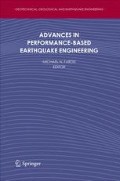Abstract
No actual data based on observations are available for high-rise buildings subjected to long-period ground motions. In order to acquire realistic data on the damage, a series of large-scale shaking table tests were conducted in E-Defense, a large shaking table facility. The paper presents ongoing high-rise building projects at E-Defense. First, the earthquake threats of Japan and the backgrounds of E-Defense are introduced. Second, a series of shaking table tests for the seismic performance of building structures are presented. In these tests a number of cyclic deformations are applied to a steel moment frame. Third, a shaking table test focusing on the safety of rooms is presented. The test reproduced large responses of floors, characterized by large velocities and displacements.
Access this chapter
Tax calculation will be finalised at checkout
Purchases are for personal use only
References
Architectural Institute of Japan (1995) Preliminary reconnaissance report of the 1995 Hyogoken-Nanbu earthquake. Architectural Institute of Japan, Tokyo, 216 pp
Building Research Institute (2005). Research report on the influence of seismic retrofit technology to buildings subjected to long-period ground motion. Tokyo, Japan (in Japanese)
Council of National Disaster Mitigation (2004). http://www.bousai.go.jp/jishin/chubou.html (in Japanese)
Fukushima T, Ichimura S, Teramoto T (1999) The basic feature history of high rise building. Architectural Institute of Japan, Tokyo, pp 307–308 (in Japanese)
Hyogo Earthquake Engineering Research Center, National Research Institute for Earth Science and Disaster Prevention (2005). http://www.bosai.go.jp/hyogo/ehyogo/index.html
Kamae K, Kawabe H, Irikura K (2004) Strong ground motion prediction for huge subduction earthquakes using a characterized source model and several simulation techniques. Proceedings of the13th world conference on earthquake engineering, Vancouver, Canada, pp 655–666
Kawabe H, Kaname K, Irikura K (2008). Damage prediction of long-period structures during subduction earthquakes-Part 1: Long-period ground motion prediction in the Osaka basin for future Nankai Earthquakes. Proceedings of the 14th world conference on earthquake engineering, Beijing, China
Kinki Branch of the Architectural Institute of Japan (1995). Reconnaissance Report on damage to steel building structure observed from the 1995 Hyogoken-Nanbu Earthquake, Steel Committee, Osaka (in Japanese with attached abridged English version)
Nakashima M (2001) Appendix C. Overview of damage to steel building structures observed in the 1995 Kobe Earthquake, Past Performance of Steel Moment-Frame Buildings in Earthquakes, Federal Emergency Management Agency, Report FEMA-355E, C-1-C24
Nakashima M, Inoue K, Tada M (1998a). Classification of damage to steel buildings observed in the 1995 Hyogoken-Nanbu Earthquake. Eng Struct 20:4–6, 271–281
Nakamura I, Shimizu H, Minowa C, Sakamoto I, Suzuki Y (2008) E-Defense experiments on full-scale wooden houses. Proceedings of the 14th World conference on earthquake engineering, Beijing, China
Suita K, Yamada S, Tada M, Kasai K, Matsuoka Y, Shimada Y (2008) Collapse experiment on 4-story steel moment frame: part 2 detail of collapse behavior. Proceedings of the 14th world conference on earthquake engineering, Beijing, China
Author information
Authors and Affiliations
Corresponding author
Editor information
Editors and Affiliations
Rights and permissions
Copyright information
© 2010 Springer Netherlands
About this chapter
Cite this chapter
Nagae, T., Kajiwara, K., Inoue, T., Nakashima, M. (2010). Large Scale Shaking Table Tests for High-Rise Buildings: New Projects of E-Defense. In: Fardis, M. (eds) Advances in Performance-Based Earthquake Engineering. Geotechnical, Geological and Earthquake Engineering, vol 13. Springer, Dordrecht. https://doi.org/10.1007/978-90-481-8746-1_43
Download citation
DOI: https://doi.org/10.1007/978-90-481-8746-1_43
Published:
Publisher Name: Springer, Dordrecht
Print ISBN: 978-90-481-8745-4
Online ISBN: 978-90-481-8746-1
eBook Packages: Earth and Environmental ScienceEarth and Environmental Science (R0)

